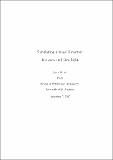Files in this item
Simulating ultracold matter: horizons and slow light
Item metadata
| dc.contributor.advisor | Leonhardt, Ulf | |
| dc.contributor.author | Farrell, Conor | |
| dc.coverage.spatial | 113 | en |
| dc.date.accessioned | 2008-01-28T11:38:28Z | |
| dc.date.available | 2008-01-28T11:38:28Z | |
| dc.date.issued | 2008-06-19 | |
| dc.identifier.uri | https://hdl.handle.net/10023/416 | |
| dc.description.abstract | This thesis explores the links between different ways of modelling the physical world. Finite difference numerical simulations may be used to encode the behaviour of physical systems, allowing us to gain insight into their workings and even to predict their behaviour. Similarly, one can investigate the properties of gravitational black holes through the use of analogue black holes, physical systems which share at least some part of the physics of the astronomical objects. Concentrating on black hole analogues using Bose-Einstein condensates, I show how simulations of these systems may be greatly assisted through the use of a proper absorbing boundary condition, the Perfectly Matched Layer. Such a boundary condition allows the effcient truncation of the computational domain, both saving computational time and increasing accuracy. I then apply this technique to the simulation of the supersonic flow of a Bose-Einstein condensate through a Laval nozzle, a black hole analogue, showing that such a flow should be stable and observable in the laboratory. Moving to a related system, I investigate the optical analogue of the Iordanskii force - the friction resulting from interaction between excitations in a superfluid's normal component and a superfluid vortex - through the simulation of such a vortex in a Bose-Einstein condensate illuminated by slow light, which is light whose group velocity is on the order of metres per second. The interaction of the slow light with the vortex should produce a momentum transfer due to the optical Aharonov-Bohm effect, exerting a force on the vortex. The coupled system of equations describing the condensate-slow light system is simulated, giving some surprising results. | en |
| dc.format.extent | 2025805 bytes | |
| dc.format.mimetype | application/pdf | |
| dc.language.iso | en | en |
| dc.publisher | University of St Andrews | |
| dc.rights | Creative Commons Attribution-NonCommercial-NoDerivs 3.0 Unported | |
| dc.rights.uri | http://creativecommons.org/licenses/by-nc-nd/3.0/ | |
| dc.subject | Finite difference | en |
| dc.subject | Numerical simulation | en |
| dc.subject | Black hole | en |
| dc.subject | Bose-Einstein condensate | en |
| dc.subject | Perfectly Matched Layer | en |
| dc.subject | Slow light | en |
| dc.subject | Aharonov-Bohm effect | en |
| dc.subject.lcc | QB843.B55F2 | |
| dc.subject.lcsh | Black holes (Astronomy)--Mathematical models | en |
| dc.subject.lcsh | Mathematical models | en |
| dc.subject.lcsh | Finite differences | en |
| dc.subject.lcsh | Bose-Einstein condensation | en |
| dc.subject.lcsh | Light | en |
| dc.title | Simulating ultracold matter: horizons and slow light | en |
| dc.type | Thesis | en |
| dc.type.qualificationlevel | Doctoral | en |
| dc.type.qualificationname | PhD Doctor of Philosophy | en |
| dc.publisher.institution | The University of St Andrews | en |
This item appears in the following Collection(s)
Except where otherwise noted within the work, this item's licence for re-use is described as Creative Commons Attribution-NonCommercial-NoDerivs 3.0 Unported
Items in the St Andrews Research Repository are protected by copyright, with all rights reserved, unless otherwise indicated.


